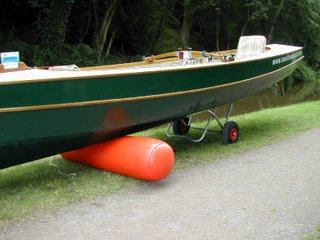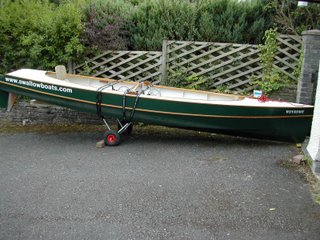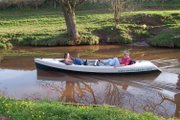

A fully laden Winsome is too heavy for her crew to lift or carry any distance. Fortunately, she fits well on any open (Canadian) canoe trolley. These will easily take the weight because they are designed to carry large canoes with their considerable cargo. As with a canoe, you do need to make sure that the boat is centred on the trolley, and lash the boat to the trolley so that it stays that way.
There are two portage scenarios we have tried:
- (Storing and) Wheeling the boat from home or car park to slipway.
- Extracting the boat from a canal to carry round locks.
If you don't need to transport the boat any distance on land other than on a trailer or roof rack, you can consider manhandling the empty hull. This weighs about 120 pounds, but is quite easy for two people to lift and carry short distances. Once the propeller and rudder are fitted - which you can do on the trailer or roofrack - you can put the boat in the water and fit the "engine" and seats while afloat. This is a little more fiddly than doing it on a trolley, but not much.
But if, like us, you live 2oo yards from the nearest launch point, or if you want to scoot past a fleet of narrow-boats passing through a flight of locks (yawn), then you need something that will carry a fully laden boat, whatever it is has to fit in the boat, and you need to consider how to get the boat in and out of the water.
The system we have developed consists of a Canadian Canoe trolley (currently we're using an Eckla one, but anything that will take the weight will probably do), an inflatable boat roller, and a hand pump (optional) to inflate the roller quickly.
The fully laden boat can be launched over the bank directly from the trolley, but it's harder to do recover the boat from the water that way. The roller is used to extract the boat from the water. You need to beach or come alongside somewhere you can reach down, grab the foot of the bow, and lift her out of the water onto the roller. If you can do that, you can then haul the boat ashore, pushing down on the bow to lift the (heavier) stern clear of the water and the bank. You then have your boat ashore and dripping, her bow resting on the ground and the roller just under the propeller shaft.
Now you may need to manoevre her a little so that the roller is well forward of the middle of the boat, enabling you to lift the stern and your partner to place the trolley underneath the boat just aft of the centre of gravity (which in a fully laden boat will be about a foot astern of mid-ships). Make sure the boat is centred on the trolley and aligned. The second picture shows the boat recovered from the canal and resting on the tolley and the roller. You can then lash the boat onto the trolley and remove the roller. You can do this with a single 6M cambuckle lash, but the lashing needs to go twice round the boat about a foot apart because it not only has to keep the boat on the trolley but also keep her aligned. When you hit bumps and rocks on the road, the trolley has a tendency to twist if not lashed down tightly. and if you aren't careful you end up "crabbing".
With the trolley in place and the boat lashed down, one person can wheel a Winsome by bearing down gently on the stern to raise the bow and pushing her forward. You do need to think about keeping the bow off the ground, and also about the length of the boat, but it's otherwise fairly easy and we've bypassed a lock flight of nearly a mile in this way, saving ourselves at least an hour. The length of the boat means you need to plan your turns (especially when going under bridges on canal towpaths) because the boat overhangs about 9 feet in front of her only contact with the ground. But after you've side-swiped your first toddler into the water you will quickly get the hang of it.

No comments:
Post a Comment